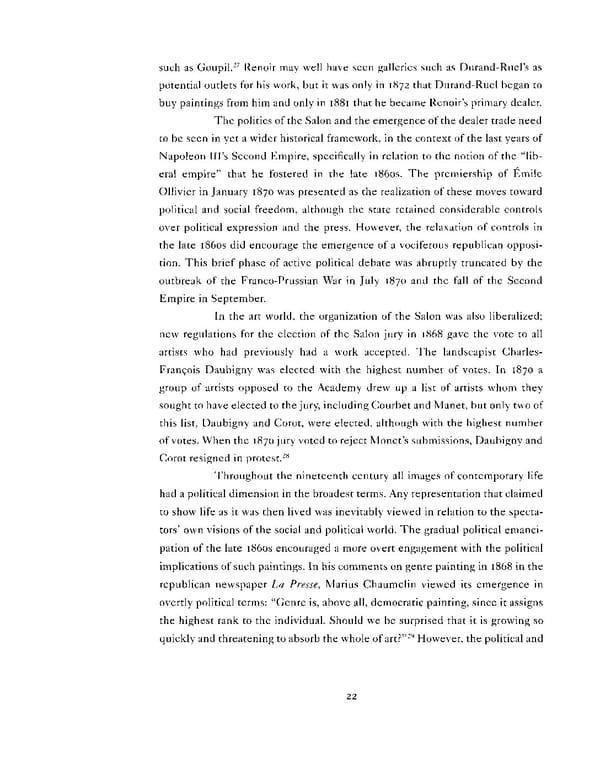27 such as Goupil. r may well have seen galleries such as Durand-Ruel's as Renoi potential outlets for his work, but it was only in 1872 that Durand-Ruel began to buy paintings from him and only in 1881 that he became Renoir's primary dealer. The politics of the Salon and the emergence of the dealer trade need to be seen in yet a wider historical framework, in the context of the last years of Napoleon Ill's Second Empire, specifically in relation to the notion of the "lib- eral empire" that he fostered in the late i86os. The premiership of Emile Ollivier in January 1870 was presented as the realization of these moves toward political and social freedom, although the state retained considerable controls over political expression and the press. However, the relaxation of controls in the late i86os did encourage the emergence of a vociferous republican opposi- tion. This brief phase of active political debate was abruptly truncated by the outbreak of the Franco-Prussian War in July 1870 and the fall of the Second Empire in September. In the art world, the organization of the Salon was also liberalized; new regulations for the election of the Salon jury in 1868 gave the vote to all artists who had previously had a work accepted. The landscapist Charles- Fran9ois Daubigny was elected with the highest number of votes. In 1870 a group of artists opposed to the Academy drew up a list of artists whom they sought to have elected to the jury, including Gourbet and Manet, but only two of this list, Daubigny and Gorot, were elected, although with the highest number of votes. When the 1870 jury voted to reject Monet's submissions, Daubigny and 28 Gorot resigned in protest. Throughout the nineteenth century all images of contemporary life had a political dimension in the broadest terms. Any representation that claimed to show life as it was then lived was inevitably viewed in relation to the specta- tors' own visions of the social and political world. The gradual political emanci- pation of the late i86os encouraged a more overt engagement with the political implications of such paintings. In his comments on genre painting in 1868 in the republican newspaper La Presse, Marius Chaumelin viewed its emergence in overtly political terms: "Genre is, above all, democratic painting, since it assigns the highest rank to the individual. Should we be surprised that it is growing so 29 quickly and threatening to absorb the whole of art?" However, the political and 22
 Pierre-Auguste Renoir: La Promenade Page 29 Page 31
Pierre-Auguste Renoir: La Promenade Page 29 Page 31